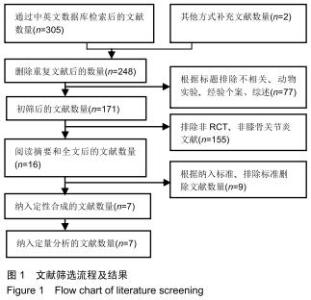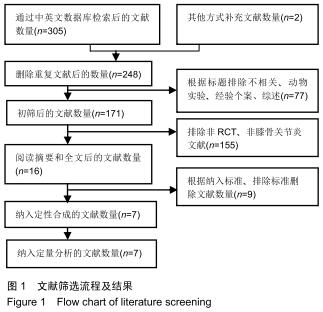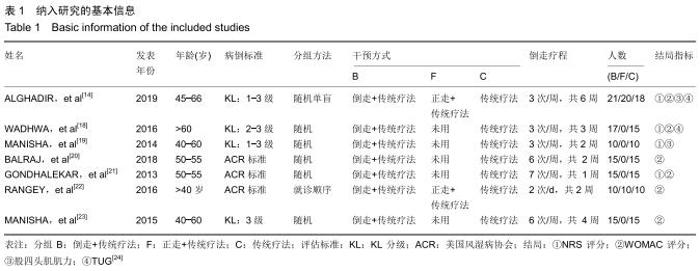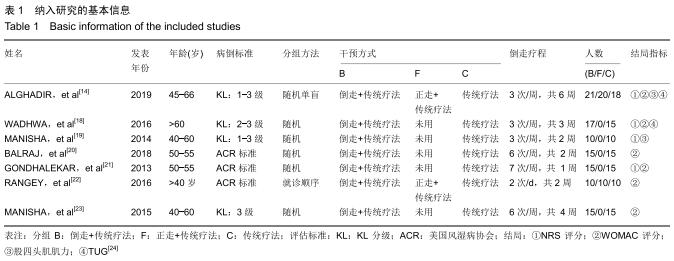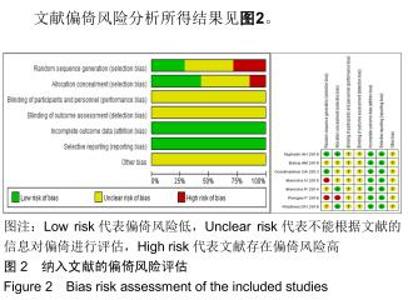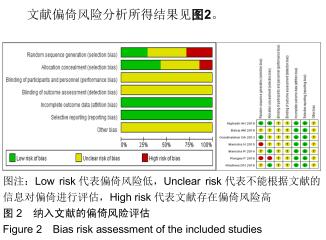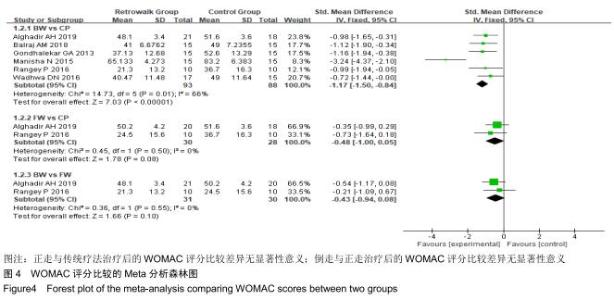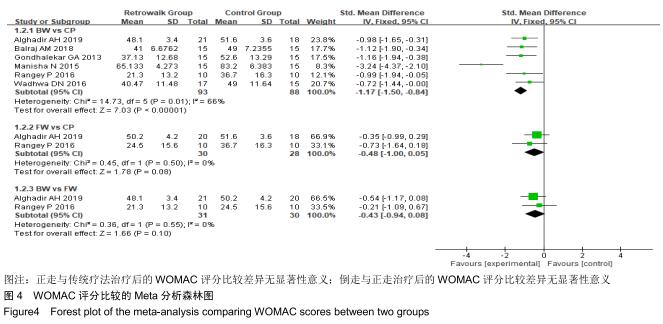Chinese Journal of Tissue Engineering Research ›› 2020, Vol. 24 ›› Issue (26): 4251-4256.doi: 10.3969/j.issn.2095-4344.2770
Previous Articles Next Articles
Effectiveness of backward walking training on knee osteoarthritis: a systematic review and meta-analysis
Chen Zehua1, Ye Xiangling1, Chen Weijian1, Xu Xuemeng1, 2
1The Fifth Clinical Medical College of Guangzhou University of Chinese Medicine, Guangzhou 510405, Guangdong Province, China; 2The Second Chinese Medicine Hospital of Guangdong Province, Guangzhou 510405, Guangdong Province, China
-
Received:2019-11-08Revised:2019-11-14Accepted:2019-12-05Online:2020-09-18Published:2020-09-03 -
Contact:Xu Xuemeng, Professor, Chief physician, Doctoral supervisor, the Fifth Clinical Medical College of Guangzhou University of Chinese Medicine, Guangzhou 510405, Guangdong Province, China; the Second Chinese Medicine Hospital of Guangdong Province, Guangzhou 510405, Guangdong Province, China -
About author:Chen Zehua, MD candidate, Attending physician, the Fifth Clinical Medical College of Guangzhou University of Chinese Medicine, Guangzhou 510405, Guangdong Province, China -
Supported by:Guangdong Province Famous Chinese Medicine Heritage Studio Construction Project, No. Guangdong Traditional Chinese Medicine Office Letter [2017]17; Guangdong Provincial Special Fund for Industrial and Information Development, No. Guangdong Finance and Industry [2016]69; National Administration of Traditional Chinese Medicine Key Specialized Construction Project, No. Guangdong Traditional Chinese Medicine [2012]7; Guangdong Natural Science Foundation-Doctor Launched, No. 2014A030310128; Breakthrough Projects of Superiority Diseases of Traditional Chinese Medicine in Guangdong Province, No. [2015]19; Guangdong Science and Technology Plan Project, No. 20191401
CLC Number:
Cite this article
Chen Zehua, Ye Xiangling, Chen Weijian, Xu Xuemeng.
Effectiveness of backward walking training on knee osteoarthritis: a systematic review and meta-analysis [J]. Chinese Journal of Tissue Engineering Research, 2020, 24(26): 4251-4256.
share this article
|
[1] HUNTER DJ, BIERMA-ZEINSTRA S. Osteoarthritis. Lancet. 2019;393(10182):1745-1759.
[2] ZHAO M, LIANG Y, WANG X, et al. Chinese primary knee osteoarthritis progression cohort (CPKOPC) to evaluate the progression of knee osteoarthritis in the Beijing population: a prospective cohort study protocol.BMJ Open.2019;9(8): e029430.
[3] SHORTER E, SANNICANDRO AJ, POULET B, et al. Skeletal Muscle Wasting and Its Relationship With Osteoarthritis: a Mini-Review of Mechanisms and Current Interventions. Curr Rheumatol Rep.2019; 21(8): 40.
[4] HASSAN BS, MOCKETT S, DOHERTY M. Static postural sway, proprioception, and aximal voluntary quadriceps contraction in patients with knee osteoarthritis and normal control subjects. Ann Rheum Dis.2001;60(6):612-618.
[5] TINETTI ME, SPEECHLEY M, GINTER SF. Risk factors for falls among elderly persons living in the community.N Engl J Med.1988;319(26):1701-1707. [6] JOSHI S, VIJ JS, SINGH SK. Medical science retrowalking: a new concept in physiotherapy and rehabilitation.Int J Sci Res. 2015;4:152-156.
[7] WANG J, YUAN W, AN R. Effectiveness of backward walking training on spatial-temporal gait characteristics:A systematic review and meta-analysis.Human movement science.2018;60: 57-71.
[8] ABDELRAOUF OR, ABDEL-AZIEM AA, AHMED AA, et al. Backward walking alters vastus medialis oblique/vastus lateralis muscle activity ratio in females with patellofemoral pain syndrome.Turk J Phys Med Rehabil.2019; 65(2): 169-176.
[9] SEDHOM MG. Backward walking training improves knee proprioception in non-athletic males.Int J Physiother. 2017;1: 33-37.
[10] SHEN M, CHE S, YE D, et al. Effects of backward walking on knee proprioception after ACL reconstruction.Physiother Theory Pract.2019; 21:1-8.
[11] M RASHIJ, HR RAI, R SIVAPRIYA, et al. Resisted backward walking to improve gait synergism in children with hemiparetic cerebral palsy. Indian J Physiother Occup Ther.2017; 2: 74-78.
[12] 巴洪冰,程亮.倒走过程中老年女性平衡能力及下肢肌力和神经肌肉的反应[J].中国组织工程研究,2018, 22(20): 3161-3166.
[13] WANG J, XU J, AN R. Effectiveness of backward walking training on balance performance: A systematic review and meta-analysis. Gait Posture.2019;68:466-475.
[14] ALGHADIR AH, ANWER S, SARKAR B, et al. Effect of 6-week retro or forward walking program on pain, functional disability, quadriceps muscle strength, and performance in individuals with knee osteoarthritis: a randomized controlled trial (retro-walking trial).BMC Musculoskelet Disord, 2019; 20(1):159.
[15] WALLIS JA, WEBSTER KE, LEVINGER P, et al.A walking program for people with severe knee osteoarthritis did not reduce pain but may have benefits for cardiovascular health: a phase II randomised controlled trial.Osteoarthr Cartil.2017; 25(12):1969-1979.
[16] HIGGINS JP, ALTMAN DG, GOTZSCBE PC, et al. The Cochrane Collaboration’s tool for assessing risk of bias in randomised trials.BMJ.2011;343: d5928.
[17] HUEDO-MEDINA TB, SÁNCHEZ-MECA J, MARÍN-MARTÍNEZ F, et al.Assessing heterogeneity in meta-analysis: Q statistic or I2 index? .Psychol Methods. 2006;11(2):193-206.
[18] WADHWA DN, HANDE DN. Effects of retrowalking on osteoarthritis of knee in geriatric population. IOSR J Sports Phys Educ.2016;3:37-43.
[19] MANISHA R, TUSHAR P, ANJUMOL V. Efficacy of backward walking on patients with osteoarthritis of knee on quadriceps strength, pain and physical functions. Indian J Physiother Occup Ther Int J.2014; 8:192-196. [20] BALRAJ AM, KUTTY RK, KAMRAJ B, et al. Impact of Retro-Walking on Pain and Disability Parameters among Chronic Osteoarthritis Knee Patients.Physiother Rehabil.2018; 3(157): 2573-0312.
[21] GONDHALEKAR GA, DEO MV. Retrowalking as an adjunct to conventional treatment versus conventional treatment alone on pain and disability in patients with acute exacerbation of chronic knee osteoarthritis: a randomized clinical trial.N Am J Med Sci.2013;5(2):108-112.
[22] RANGEY P, SHETH M, VYAS N. Comparison of effectiveness of forward and backward walking on pain, physical function, and quality of life in subjects with osteoarthritis of knee.Int J Health Allied Sci.2016;5:220-226.
[23] MANISHA N, JOGINDER Y, PRIYANKA R. Effect of retro walking on pain, balance and functional performance in osteoarthritis of knee.Indian J Physiother Occup Ther Int J.2015; 9:154-159.
[24] PODSIADLO D, RICHARDSON S. The timed “up & go”: a test of basic functional mobility for frail elderly persons.J Am Geriatr Soc.1991;39:142-148.
[25] ALGHADIR A, ANWER S. Effect of retro and forward walking on quadriceps muscle strength, pain, function, and mobility in patients with knee osteoarthritis: a protocol for a randomized controlled trial.BMC Musculoskelet Disord.2016;17:161.
[26] FRITZ NE, WORSTELL AM, KLOOS AD, et al. Backward walking measures are sensitive to age-related changes in mobility and balance.Gait & posture.2013;37(4):593-597.
[27] CHALOUPKA EC, KANG J, MASTRANGELO MA, et al. Cardiorespiratory and metabolic responses during forward and backward walking.J Orthop Sports Phys Ther. 1997;25(5): 302-306.
[28] KWON HJ, XIANG Y, BHATT R, et al. Backward walking simulation of humans using optimization. Structural and multidisciplinary optimization.2014;50(1):169-179.
[29] GROBBELAAR R, VENTER R, WELMAN KE. Backward compared to forward over ground gait retraining have additional benefits for gait in individuals with mild to moderate Parkinson’s disease: a randomized controlled trial.Gait Posture.2017;58:294-299.
[30] ABDEL-AZIEM AA, EL-BASATINY HMY. Effectiveness of backward walking training on walking ability in children with hemiparetic cerebral palsy: a randomized controlled trial.Clin Rehabil.2017;31(6):790-797.
[31] ROSE DK, DEMARK L, FOX EJ, et al. A backward walking training program to improve balance and mobility in acute stroke: a pilot randomized controlled trial.J Neurol Phys Ther. 2018;42(1):12-21.
[32] DUFEK J, HOUSE A, MANGUS B, et al. Backward Walking: A Possible Active Exercise for Low Back Pain Reduction and Enhanced Function in Athletes. Journal of Exercise Physiology online.2011;14(2): 17-26.
[33] JOSHI S, SINGH SK, VIJ JS. Effect of Retrowalking, a Non-Pharmacological Treatment on Pain, Disability, Balance and Gait in Knee Osteoarthritis: A Randomized Controlled Trial.Indian Journal of Public Health Research & Development. 2019;10(2): 214-219. |
| [1] | Chen Junming, Yue Chen, He Peilin, Zhang Juntao, Sun Moyuan, Liu Youwen. Hip arthroplasty versus proximal femoral nail antirotation for intertrochanteric fractures in older adults: a meta-analysis [J]. Chinese Journal of Tissue Engineering Research, 2021, 25(9): 1452-1457. |
| [2] | Chen Jinping, Li Kui, Chen Qian, Guo Haoran, Zhang Yingbo, Wei Peng. Meta-analysis of the efficacy and safety of tranexamic acid in open spinal surgery [J]. Chinese Journal of Tissue Engineering Research, 2021, 25(9): 1458-1464. |
| [3] | Hu Kai, Qiao Xiaohong, Zhang Yonghong, Wang Dong, Qin Sihe. Treatment of displaced intra-articular calcaneal fractures with cannulated screws and plates: a meta-analysis of 15 randomized controlled trials [J]. Chinese Journal of Tissue Engineering Research, 2021, 25(9): 1465-1470. |
| [4] | Huang Dengcheng, Wang Zhike, Cao Xuewei. Comparison of the short-term efficacy of extracorporeal shock wave therapy for middle-aged and elderly knee osteoarthritis: a meta-analysis [J]. Chinese Journal of Tissue Engineering Research, 2021, 25(9): 1471-1476. |
| [5] | Wang Yongsheng, Wu Yang, Li Yanchun. Effect of acute high-intensity exercise on appetite hormones in adults: a meta-analysis [J]. Chinese Journal of Tissue Engineering Research, 2021, 25(8): 1305-1312. |
| [6] | Kong Desheng, He Jingjing, Feng Baofeng, Guo Ruiyun, Asiamah Ernest Amponsah, Lü Fei, Zhang Shuhan, Zhang Xiaolin, Ma Jun, Cui Huixian. Efficacy of mesenchymal stem cells in the spinal cord injury of large animal models: a meta-analysis [J]. Chinese Journal of Tissue Engineering Research, 2021, 25(7): 1142-1148. |
| [7] | Huang Dengcheng, Wang Zhike, Cao Xuewei. Intravenous, topical tranexamic acid alone or their combination in total knee arthroplasty: a meta-analysis of randomized controlled trials [J]. Chinese Journal of Tissue Engineering Research, 2021, 25(6): 948-956. |
| [8] | Li Yan, Wang Pei, Deng Donghuan, Yan Wei, Li Lei, Jiang Hongjiang. Electroacupuncture for pain control after total knee arthroplasty: a meta-analysis [J]. Chinese Journal of Tissue Engineering Research, 2021, 25(6): 957-963. |
| [9] | He Xiangzhong, Chen Haiyun, Liu Jun, Lü Yang, Pan Jianke, Yang Wenbin, He Jingwen, Huang Junhan. Platelet-rich plasma combined with microfracture versus microfracture in the treatment of knee cartilage lesions: a meta-analysis [J]. Chinese Journal of Tissue Engineering Research, 2021, 25(6): 964-969. |
| [10] | Hua Haotian, Zhao Wenyu, Zhang Lei, Bai Wenbo, Wang Xinwei. Meta-analysis of clinical efficacy and safety of antibiotic artificial bone in the treatment of chronic osteomyelitis [J]. Chinese Journal of Tissue Engineering Research, 2021, 25(6): 970-976. |
| [11] | Zhan Fangbiao, Cheng Jun, Zou Xinsen, Long Jie, Xie Lizhong, Deng Qianrong. Intraoperative intravenous application of tranexamic acid reduces perioperative bleeding in multilevel posterior spinal surgery: a meta-analysis [J]. Chinese Journal of Tissue Engineering Research, 2021, 25(6): 977-984. |
| [12] | Cao Xuhan, Bai Zixing, Sun Chengyi, Yang Yanjun, Sun Weidong. Mechanism of “Ruxiang-Moyao” herbal pair in the treatment of knee osteoarthritis based on network pharmacology [J]. Chinese Journal of Tissue Engineering Research, 2021, 25(5): 746-753. |
| [13] | Li Yonghua, Feng Qiang, Tan Renting, Huang Shifu, Qiu Jinlong, Yin Heng. Molecular mechanism of Eucommia ulmoides active ingredients treating synovitis of knee osteoarthritis: an analysis based on network pharmacology [J]. Chinese Journal of Tissue Engineering Research, 2021, 25(5): 765-771. |
| [14] | Zhong Yuanming, Wan Tong, Zhong Xifeng, Wu Zhuotan, He Bingkun, Wu Sixian. Meta-analysis of the efficacy and safety of percutaneous curved vertebroplasty and unilateral pedicle approach percutaneous vertebroplasty in the treatment of osteoporotic vertebral compression fracture [J]. Chinese Journal of Tissue Engineering Research, 2021, 25(3): 456-462. |
| [15] | Li Yang, Zhang Mingyong. Meta-analysis of the effect of double Endobutton and clavicular hook plate on the treatment of acromioclavicular dislocation [J]. Chinese Journal of Tissue Engineering Research, 2021, 25(3): 463-470. |
| Viewed | ||||||
|
Full text |
|
|||||
|
Abstract |
|
|||||
